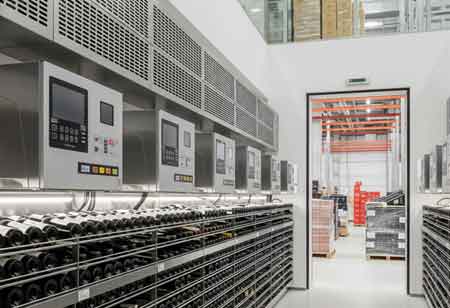Thank you for Subscribing to Food Business Review Weekly Brief
- Home
- Topics
- Alternative Proteins and Plant Based Food
- Beer and Wine
- Canned Beverages
- Coffee And Tea
- Food and Beverage Consulting
- Food and Beverage Financial Service
- Food And Beverages Marketing
- Food Distributors
- Food Ingredients
- Food Sustainability
- Plant Based Food and Beverages
- Seafood Suppliers
- Supplement Manufacturing
- Wine Investment
- News
- Vendor Viewpoint
- CXO Insights
- Conferences
- Newsletter
- CXO Awards
-
Bridging Importation with Infrastructure for Optimal Wine Storage and Distribution in F&B Facilities
The global wine market requires design for F&B facilities that focus on optimal storage conditions, efficient distribution logistics, and regulatory compliance to preserve wine quality.

By
Food Business Review | Friday, July 18, 2025
Stay ahead of the industry with exclusive feature stories on the top companies, expert insights and the latest news delivered straight to your inbox. Subscribe today.

Fremont, CA: The global wine market is a complex web, with numerous vintages traveling across continents to reach discerning palates. For food and beverage (F&B) facilities, ranging from bustling restaurants to large-scale distribution centers, the challenge lies not just in sourcing exceptional wines but in ensuring their impeccable condition from the vineyard to the glass. This requires a meticulous approach to facility design, one that seamlessly bridges the complexities of importation with robust internal infrastructure for optimal wine storage and distribution.
Key Considerations for Optimal Wine Storage
The optimal wine storage involves maintaining a consistent and appropriate temperature, with a recommended "cellar temperature" of 10-16°C (50-60°F) for long-term aging and mixed collections. High-performance insulation, dedicated cooling systems, and continuous monitoring are essential for maintaining stability. Humidity management is crucial, especially for wines sealed with natural corks, with humidity levels between 60% and 70%. Proper air circulation ensures even distribution of humidity. Light protection is essential to prevent ultraviolet light from accelerating wine aging and imparting undesirable flavors. Storage areas should be kept as dark as possible, with low-intensity lighting controlled by motion sensors or timers. Robust, securely anchored racking systems are essential, and storage layouts should minimize proximity to forklift paths or heavy equipment. Shock-dampening materials may be used in sensitive areas, and locations prone to vibrations should be avoided for wine storage. Proper ventilation prevents the accumulation of stale air and musty odors, while excessive drafts should be avoided to maintain a stable environment. Security measures are essential for fine wine collections, particularly those containing rare or high-value vintages, with access control systems, integrated surveillance cameras, and secure lockers or cages for storing valuable bottles.
Bridging Importation with Infrastructure: The Distribution Center Perspective
Wine importation and distribution businesses require efficient and reliable logistics. Cold chain management is crucial, ensuring wine stays within optimal temperature ranges from the winery to shipping, warehousing, and final delivery. This involves refrigerated containers, trucks, real-time temperature logging, and insulated staging areas. An optimized warehouse layout promotes smooth product flow and ensures quality preservation. Implementing a First-In, First-Out (FIFO) system ensures older vintages are shipped before newer ones. Maximizing vertical space through industrial wine racks and high-density mobile shelving is adequate for slower-moving collections. Clear, wide aisles facilitate the safe movement of forklifts and pallet jacks, and well-designed picking strategies streamline order fulfillment. Technology integration, such as a robust Warehouse Management System, enables real-time inventory tracking and efficient inventory management. Compliance with regulatory frameworks is essential for international wine importation. Emergency preparedness, including backup power solutions and disaster response protocols, safeguards valuable inventory and ensures uninterrupted operations in a competitive and regulated industry.
Designing F&B facilities for optimal wine storage and distribution is a multifaceted endeavor that demands meticulous attention to detail. In a competitive market where quality reigns supreme, bridging importation with a designed infrastructure is not just a best practice – it's a recipe for success.






